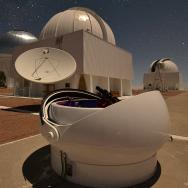“Dark energy” is a term scientists use to refer to whatever is causing the universe to expand faster over time.
We don’t know exactly what dark energy is—no one has ever directly seen or measured it—but some force seems to be currently pushing the universe to expand faster than it should, according to everything else we know about the cosmos. Whatever it is, there’s a lot of it: It appears to make up about 70% of the universe today.
Coined by University of Chicago astrophysicist Michael Turner in 1998, dark energy remains one of the great mysteries of physics.
Jump to a section:
- What is dark energy?
- How do we know dark energy is there?
- What does it tell us about the universe?
- What do we know and not know about dark energy?
- What are the possible explanations for dark energy?
- Why is it called dark energy?
- What’s the difference between dark energy and dark matter?
- How do we figure out what dark energy is?
- What experiments are studying dark energy?
- Why is dark energy so difficult to figure out?
What is dark energy?
“Dark energy” is a term scientists use to refer to whatever is causing the universe to expand faster over time. It’s a catchall term because we don’t know exactly what dark energy is—no one has ever directly seen or measured it.
Scientists have come up with a number of possible explanations. One of the leading concepts is the ‘cosmological constant’ theory, in which the energy of empty space itself causes cosmic acceleration. Another possible theory is known as ‘evolving dark energy’ or ‘quintessence,’ in which there is another, previously unknown field that has the opposite effect of matter and normal energy. It could also be possible that something is wrong with our theory of gravity.
“I think dark energy is the most profound mystery in all of science,” said University of Chicago astrophysicist Michael Turner, who coined the term dark energy in 1998. “Until we understand it, we can’t sensibly speculate about the destiny of the universe.”
According to current best estimates, dark energy actually makes up between 68% and 71% of all energy and matter in the universe today.
How do we know dark energy is there?
At the end of the 20th century, multiple surveys of the universe came back with a result that astonished many scientists. Although the universe has been expanding ever since the Big Bang, it was thought the expansion should slow down over time, because of gravity pulling all the galaxies together.
But in reality, the universe currently appears to be expanding faster and faster. In 1998, two different teams of astronomers studying exploding stars called supernovae found that distant galaxies were not only moving away, but doing so faster over time. Since then, other studies—including measurements of the large-scale structure of the universe, of X-rays from galaxy clusters, and of the cosmic microwave background—have found the same result.
After the initial inflation of the Big Bang, the expansion of the universe began to gradually slow down, which allowed galaxies and stars to form. “Dark energy couldn't have become the dominant thing too early in the universe, because matter would not have been able to clump together to form galaxies and stars and planets—and us,” explained UChicago Prof. Joshua Frieman, who co-founded and led the Dark Energy Survey.
But then about five billion years ago, the expansion sped up again, and that’s what we see around us today.
Surprisingly, even though we can’t see dark energy and don’t know exactly what it is, we have a very good understanding of how much of it there is. Scientists can look at supernovae that exploded billions of years ago, and track how fast the galaxies they’re in are moving away to estimate how much the universe has sped up over time, which gives us a number for the amount of dark energy we need.
As a cross-check, scientists can look at the light left over from the early years after the Big Bang and extrapolate forward to today based on what we know about the laws of the universe; the difference is how much dark energy there must be. That number is about 70% of all of the energy and matter in the universe.
"It’s a bit embarrassing that we have little to no clue what 70% of the universe is," said Frieman.
What does it tell us about the universe?
Dark energy is a signal that there’s something fundamentally missing in our theories of the universe. “Each explanation of dark energy would have big implications for our understanding of the cosmos and of the laws of physics that govern it,” Turner said.
A better understanding of dark energy would give us a better picture of how the universe began and has evolved over the past 14 billion years. Dark energy also tells us about the eventual destiny of our universe—whether over time all of the galaxies in the universe will get further and further apart, or whether the universe will collapse in on itself, or some other fate.
What do we know and not know about dark energy?
A few things about dark energy are well-established:
- We know that the repulsive gravity of dark energy pushes galaxies apart.
- We know that we cannot directly see it with telescopes or any other instruments yet devised: it doesn’t emit or interact with light.
- We know about how much dark energy there is—it currently makes up about 70% of the universe.
- We think that dark energy is relatively smooth. Unlike dark matter, which clumps around galaxies, dark energy appears to be uniformly distributed across the universe.
- We also think that dark energy only came to dominate the makeup of the universe relatively late in time, about five billion years ago. That is, five billion years ago, the repulsive gravity of dark energy overwhelmed the attractive gravity of dark matter, and the expansion of the universe transitioned from slowing down to speeding up.
There’s a lot more that we don’t know, starting with the big one: We don’t know what dark energy is. It’s a bit like a poltergeist—we can see its effects on the universe, but not the force itself.
“We don’t know what its fundamental nature is. Is it just the quantum energy of empty space? Is it a scalar field? Is it something else that we haven’t even dreamed of?” said Frieman.
We also don’t know if dark energy is changing over time, which could be a clue to its nature.
What are the possible explanations for dark energy?
There are almost as many explanations for dark energy as there are theoretical physicists, but a few have emerged as leading contenders. These include:
-
The cosmological constant or vacuum energy theory. According to this theory, dark energy is energy created by the vacuum of space. It’s named after a term Einstein invented to solve a problem in his calculations. In the early 1900s, everyone thought the universe stayed the same size, but Einstein’s theory said space is dynamic, so he invented a number called the cosmological constant to balance the equation. (He later supposedly called it “his biggest blunder” after evidence came out indicating the universe is expanding…but the concept was useful and so was reinterpreted for modern theory).
The cosmological constant theory is probably the most popular theory of dark energy, but no one is exactly sure of the properties or behavior of this energy. It could come from pairs of quantum particles appearing and disappearing almost instantaneously, but when scientists run the calculations based on our current understanding of quantum theory, the results are off (by over 100 orders of magnitude!) from what we actually see in the universe.
-
The ‘evolving dark energy’ or quintessence theory. Perhaps dark energy is the result of a field, kind of like a magnetic field, that pervades the universe. This concept has been proposed by scientists including UChicago Prof. Joshua Frieman.
A hallmark of this theory is that instead of an unchanging constant, dark energy can gradually change over eons. Several recent large-scale surveys of the universe have found hints in this direction, but we would need much more data to say so definitively.
- The something-is-wrong-with-gravity theory. Maybe Einstein’s theory of general relativity is missing something fundamental, which would screw up our calculations and perhaps make it look like the effects of dark energy. The trouble is, general relativity has held up really well through all the tests we’ve thrown at it so far.
Why is it called dark energy?
UChicago astrophysicist Michael Turner coined the term ‘dark energy’ in 1998, at a physics meeting at Mount Stromlo in Australia; it first appears in a paper titled “Dark Matter and Energy in the Universe.” The name is intended to reference dark matter, a term that was coined in 1933 to describe a similarly mysterious substance at large in the universe.
“The name was extremely intentional,” Turner said. When the evidence first began to appear for dark energy, he said, many scientists figured it was a simple problem that would be easily explained away as the cosmological constant. “I wanted a name that would say, ‘This is a really big mystery; don’t jump to conclusions.’ And I think it worked,” he said.
What’s the difference between dark energy and dark matter?
Dark energy and dark matter are two different things.
Dark matter holds galaxies and other cosmic structures together, whereas the repulsive gravity of dark energy causes the expansion of the universe to speed up.
They’re both called ‘dark’ because they don’t emit light, so no one has managed to directly observe either one, but we can deduce they must exist because of their effects on visible things in the universe.
How do we figure out what dark energy is?
The best way we currently have to better understand dark energy is to make very precise measurements of large swathes of the universe. These can be used in two ways. One is to look at bright objects, like supernovae, to see how fast they’ve been moving over time and thus measure the history of the expansion of the universe. The other approach is to look at patterns in the way that the large-scale structure of the universe has evolved over time.
There are several ways to do this:
-
By looking around us. Astronomers have made many valuable discoveries by studying galaxies to measure the rate at which the universe around us is expanding today and in the past. There are many ways to test different theories for dark energy; for example, we can look at how light is bent around large galaxies to try to understand what role dark energy played on the growth of structures, such as large galaxy clusters, in the universe. We can also plot the spatial distribution of galaxies over time and try to find patterns.
With better telescopes and surveys, such as NASA’s James Webb Space Telescope and the upcoming Vera C. Rubin Observatory and Nancy Grace Roman Space Telescope, we expect to learn even more in the coming years.
- By looking into the past. One of the primary pieces of evidence we have is the cosmic microwave background—the baby pictures of the universe. This is actually the light left over from just after the Big Bang. It has been traveling across the universe over time, and we can pick it up with incredibly sophisticated telescopes and detectors. By looking at tiny variations in this light, we can deduce many things about what the early universe looked like and how it behaved. For example, maybe quintessence left a small but characteristic mark in the cosmic microwave background that we could detect.
What experiments are studying dark energy?
Major experiments focused specifically on dark energy include:
- The Dark Energy Survey (DES), led by Fermi National Accelerator Laboratory, took measurements of the sky from 2013 to 2019 from a Chilean mountaintop; its data continue to be analyzed and released.
- The Dark Energy Spectroscopic Instrument (DESI) is an instrument located on an Arizona mountaintop, led by Lawrence Berkeley National Laboratory, which has been surveying the universe since 2021.
When the Vera C. Rubin Observatory and Nancy Grace Roman Space Telescope come online in the next few years, their measurements of the universe are expected to add at least an order of magnitude more precision.
Why is dark energy so difficult to figure out?
Right now, the only way to see dark energy’s effects is by measuring the universe at very large scales—and those are very difficult measurements to make.
“To see the effects of dark energy, we need to go beyond our galaxy, to really look at how galaxies are moving away or coming towards each other. And those are measurements that are harder to make,” explained Frieman. “You’re talking about observing hundreds of millions of galaxies with very high precision.”
“Sometimes we have a puzzle in science where we can kind of see how it’ll play out. This isn’t one of these,” said Turner. “This is a very big, very rich mystery, and the story’s going to take a while to find out. It’s possible that it could be a puzzle that we unearthed before we had the capability of solving it.”





